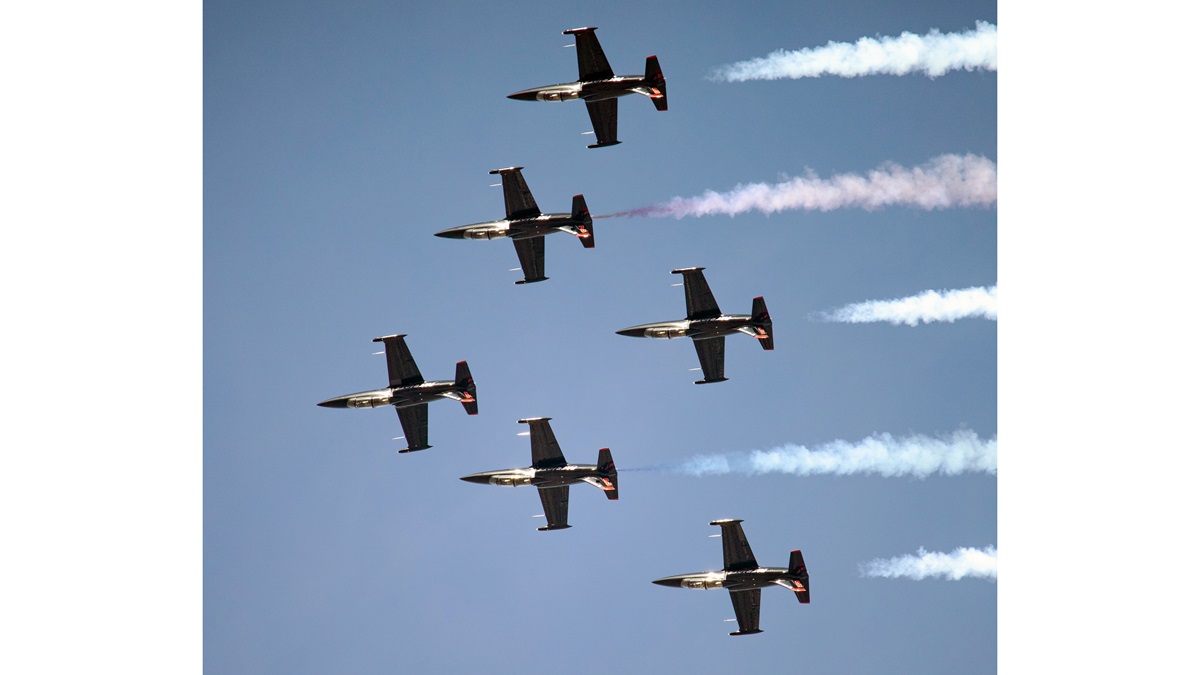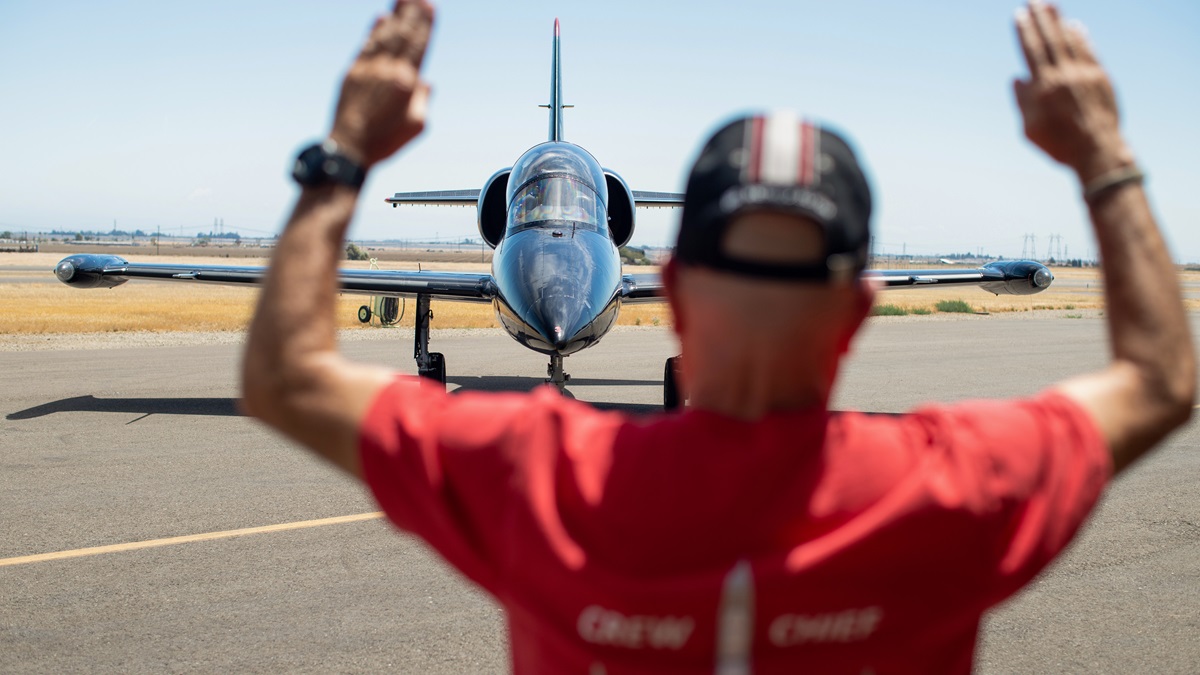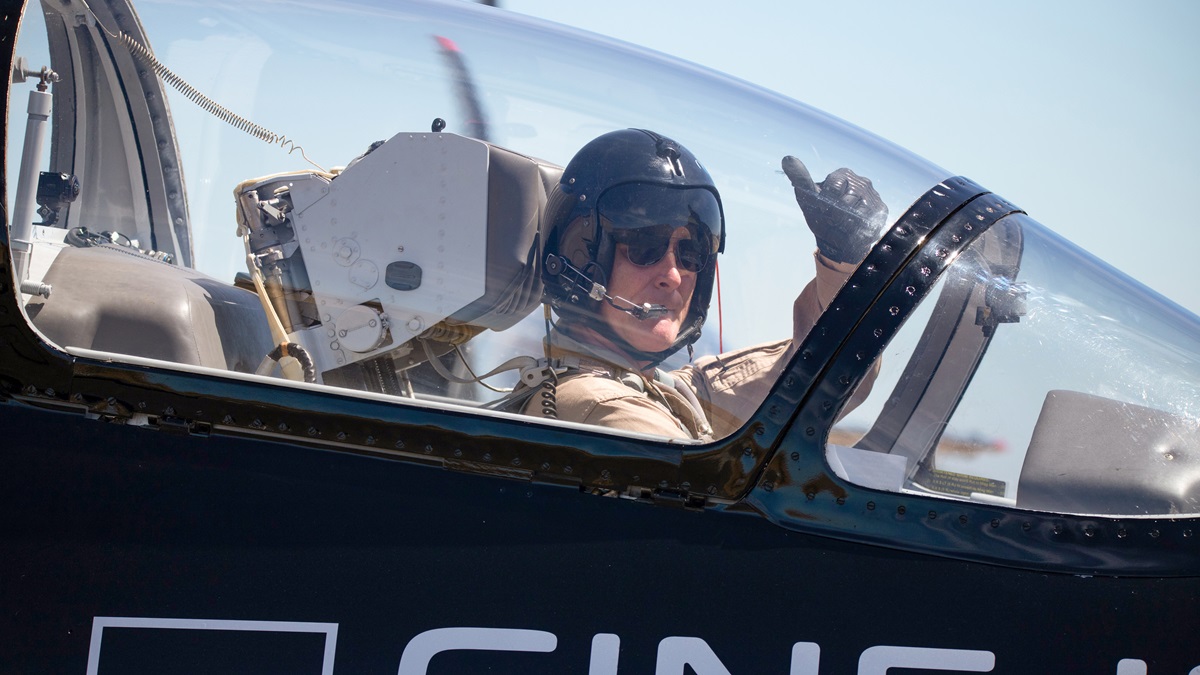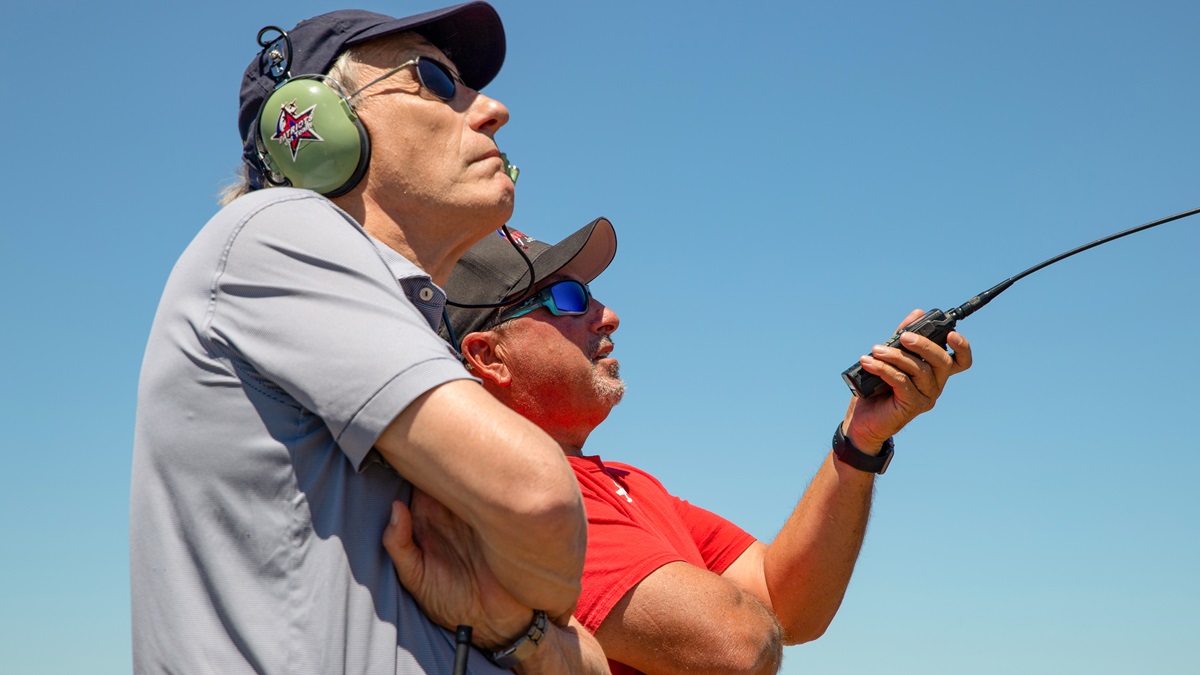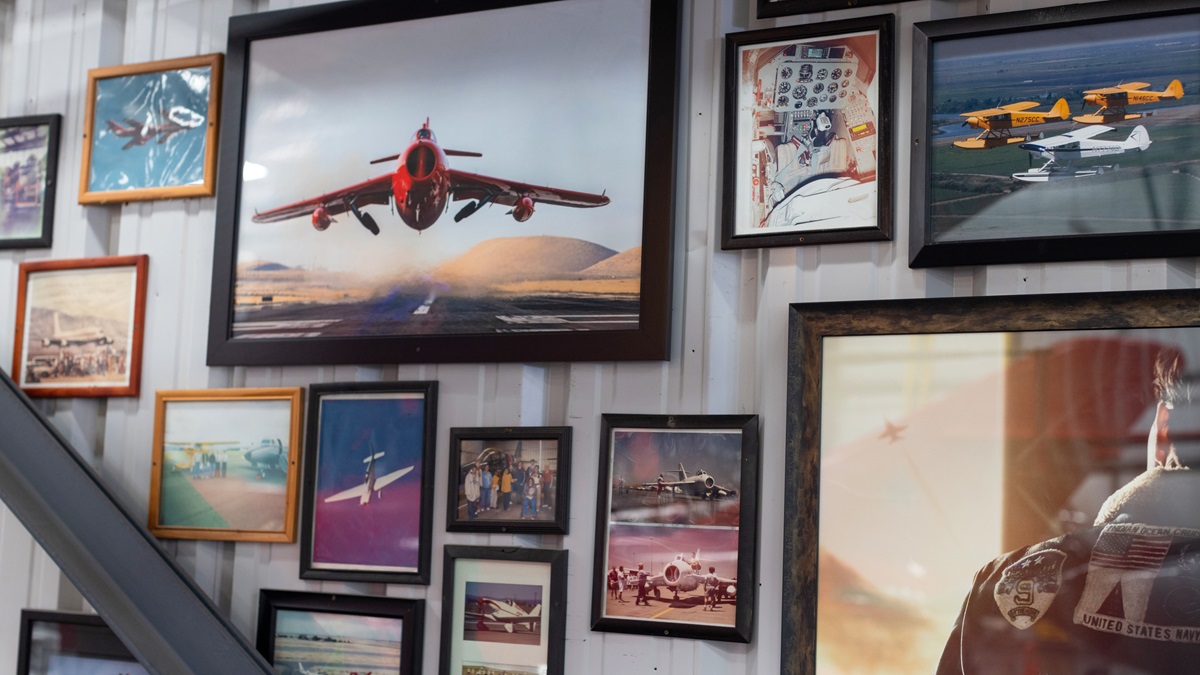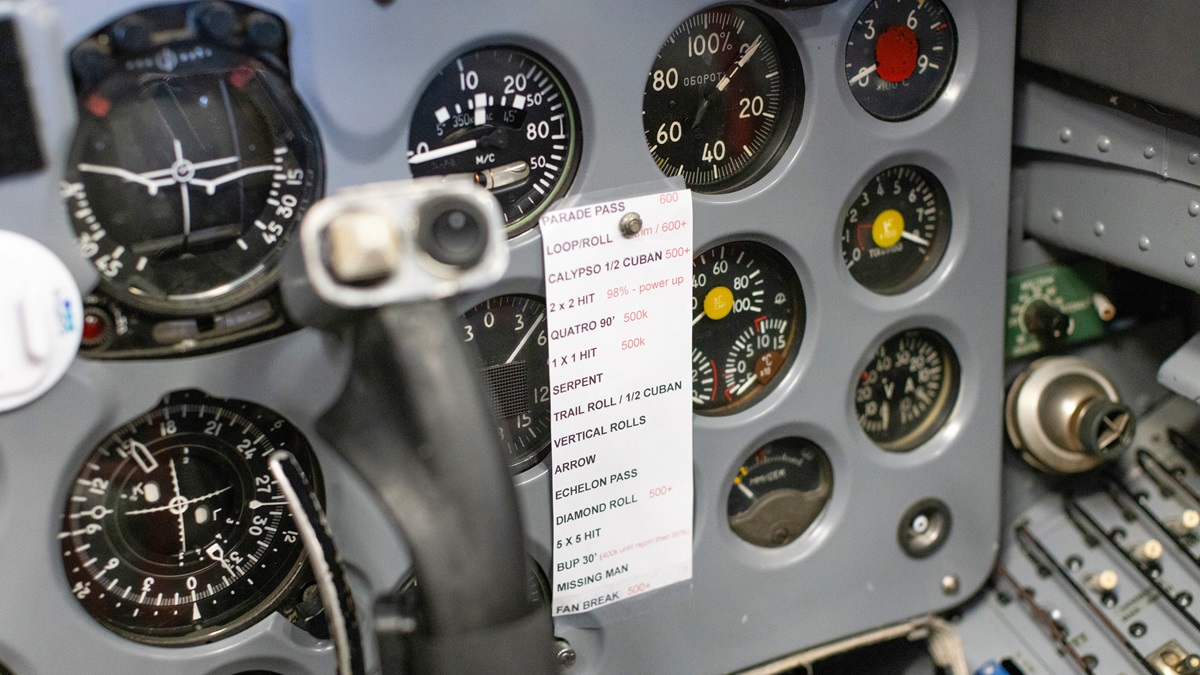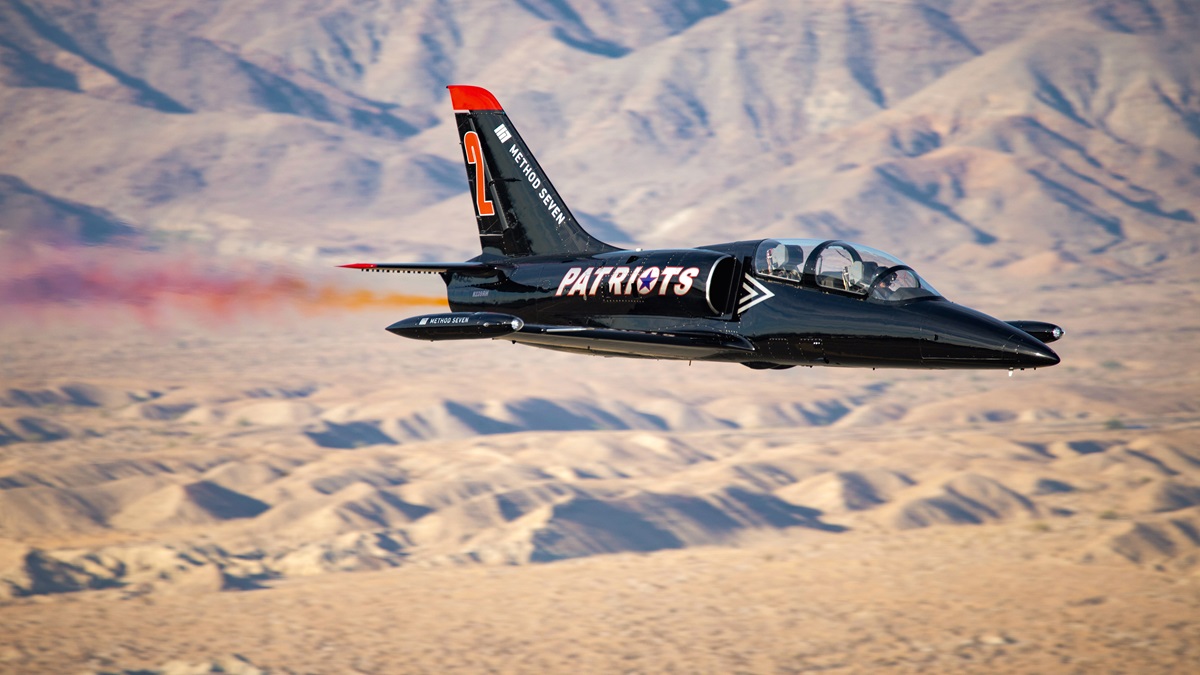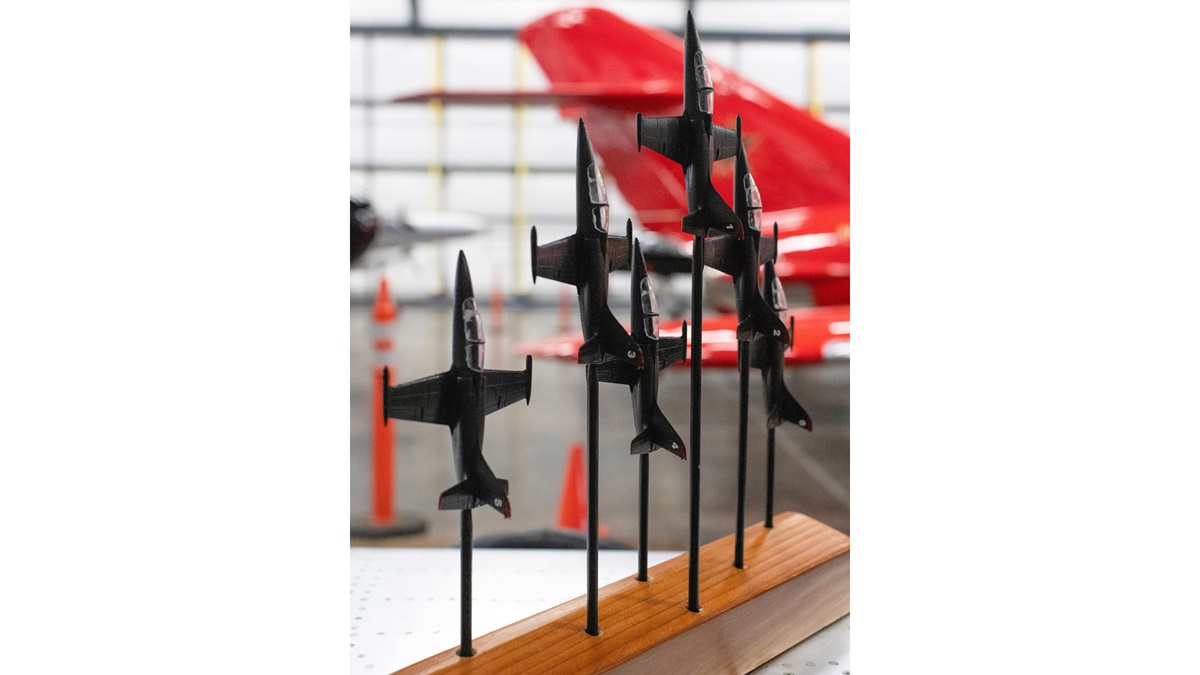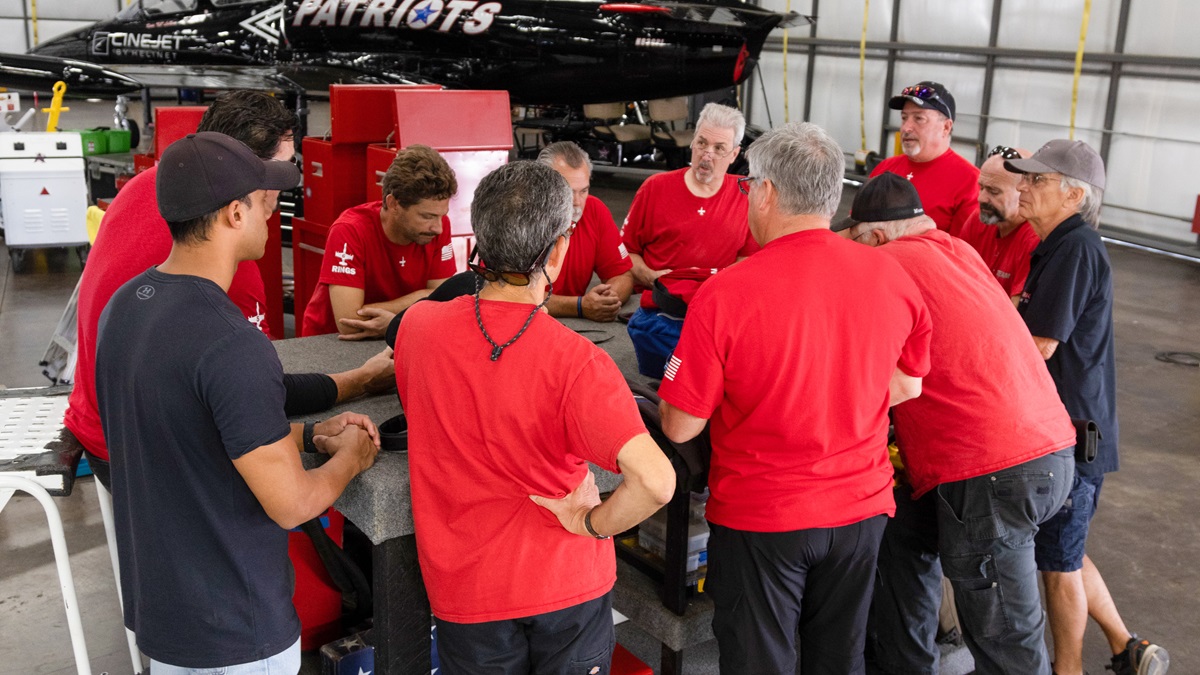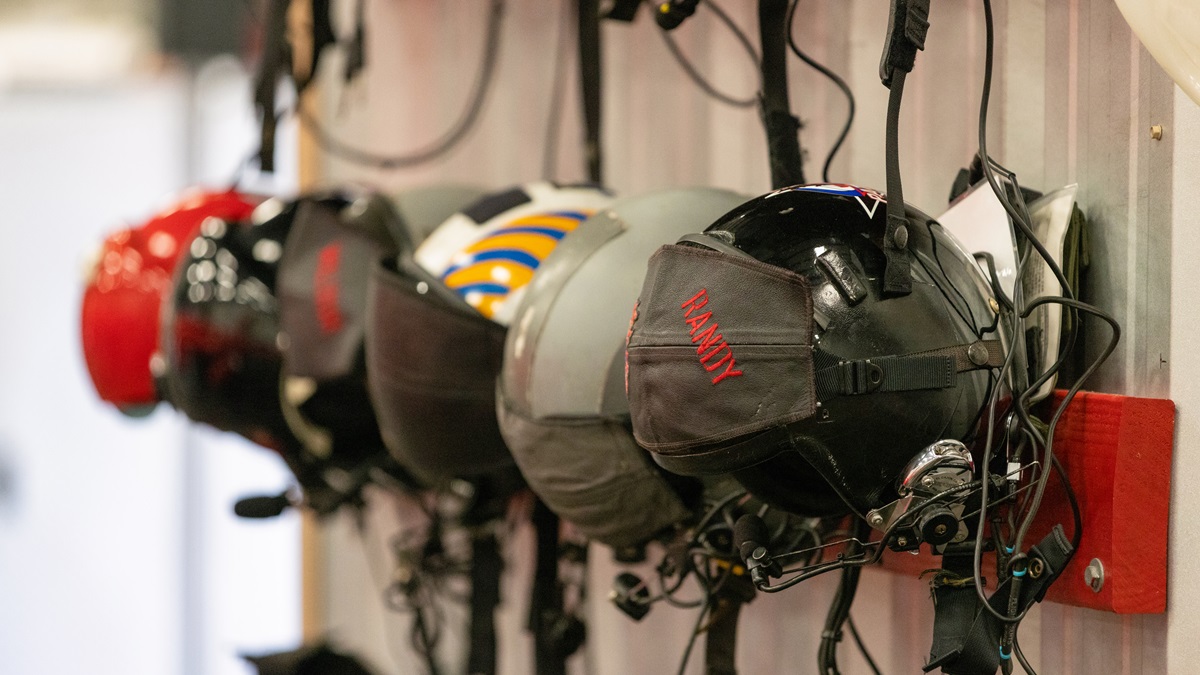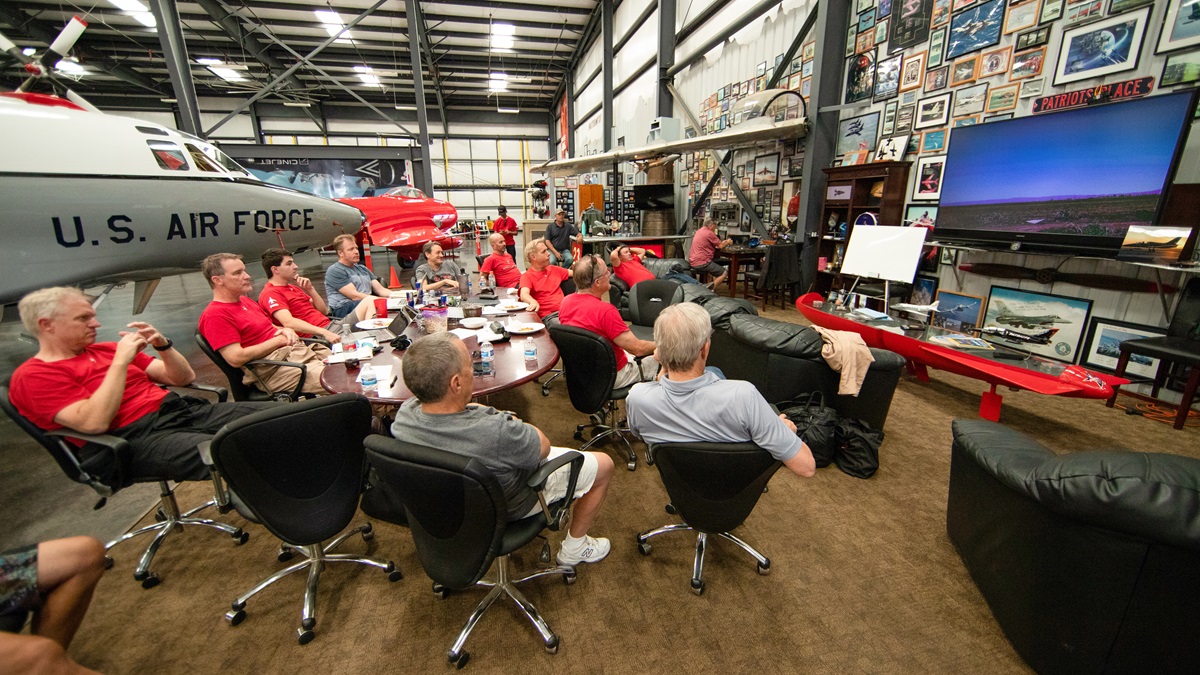Pursuit of perfection
Flying six feet apart at 400 miles per hour
By Collin Callahan
Six black L–39s trailing red, white, and blue smoke streak across the aerobatic box in front of thousands of airshow fans.
Rock music plays over the speakers while the voice of Michael Temby introduces the Patriots Jet Team, “the only civilian-owned, six-ship formation aerobatic jet team in the United States,” he proclaims. For the next 26 minutes, the pilots put on a demonstration styled after those of the U.S. Navy Blue Angels or Air Force Thunderbirds. Tight formation loops and rolls, head-to-head passes 50 feet off the ground, and even a tail slide in a jet. “It’s an airshow Patriots style,” Temby calls out.
On a warm October morning, three dozen people are gathered in the Patriots Jet Team’s hangar as the team prepares for the San Francisco Fleet Week airshow. A 35,000-square-foot hangar at Byron Airport (C83) houses the team’s eight L–39s, two Sabreliners, two MiG–17s, a STEM classroom, and a semi-truck that hauls support equipment to airshows. The back wall of the hangar is lined with photos and banners that team founder Randy Howell has collected through a nearly 30-year airshow career.
“I can’t get this style of flying anywhere else in the country.” — Dean “Wilbur” WrightIt’s like a family reunion as pilots and support personnel—all volunteers—roll in for morning briefings. Although most of the team live in the area and see each other at weekly maintenance sessions, several live out of town. Coffees are passed around as the teammates greet each other and exchange playful jeers. But almost no one is greeted by their given name. Callsigns are the norm here: Rings, Sticky, Ponch, Mojo, Stache, Smurf. A handful of team members picked up their callsigns in the military, but the majority earned them after joining the Patriots.
Some of these volunteers have been with the team since it began in 2002 and helped grow it from a two-airplane airshow act to a six-jet demonstration. Others are relative newcomers. They bring a variety of professional backgrounds—commercial pilots, tradespeople, and business professionals—but each of them brings a skill set to the team.
Dean “Wilbur” Wright, who has been the flight lead since 2004, joined the team after completing a two-year tour with the Thunderbirds. He thought he was finished with formation jet aerobatics when his tour ended, so the invitation to fly with the Patriots was too good to pass up.
“I can’t get this style of flying anywhere else in the country,” he said.
Lifelong dream
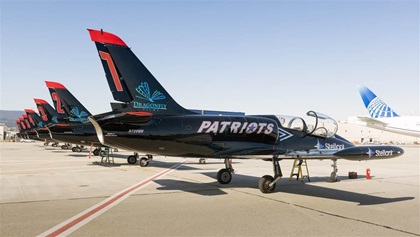 Howell isn’t certain where he got the notion to start a jet team, but his father used to remind him of what he said the first time he saw the Thunderbirds fly as a kid. His dad had asked if he wanted to fly for the Thunderbirds one day. “I want to own my own jet and my own jet team,” the young Howell had responded.
Howell isn’t certain where he got the notion to start a jet team, but his father used to remind him of what he said the first time he saw the Thunderbirds fly as a kid. His dad had asked if he wanted to fly for the Thunderbirds one day. “I want to own my own jet and my own jet team,” the young Howell had responded.
He took his first steps toward fulfilling that dream in short order. He soloed at 16, got his certificate at 17, and started a career in the airlines where he would captain the Boeing 747. In the late 1990s he began flying a two-ship MiG–17 airshow routine with another pilot. The jets were imported from Poland and arrived disassembled in shipping containers. At the time, Howell didn’t have a ground crew to help him reassemble the airplanes. He posted flyers in coffee shops and other gathering spots around town asking for help—especially from anyone who had worked on fighters in the U.S. military.
But the MiGs were antiquated and expensive to operate. He turned his focus to the L–39, a straight-wing jet trainer built in Czechoslovakia by Aero Vodochody. Originally intended to help transition military pilots to more advanced fighters, the L–39 proved an ideal airshow platform. Its design allows it to turn tightly and stay in front of the crowd, it can sustain inverted flight and easily handle aerobatics, and it has tandem seating that allows for media and VIP flights.
Howell began importing them in 1999. “They show up in a 40-foot container and we used a crane to get them out of the container,” he said. “They basically came in four parts: the fuselage, the empennage, the horizontal, stabilizer and elevator, and then the wing. In theory, you could pull those four pieces out, extend the landing gear, use the crane to set the fuselage onto the wing, which is all one piece, and then put the tail section on, and you could have the plane flying within a week.”
But it took longer to prepare the jets for the airshow circuit. Upgraded radios and avionics were installed in the airplanes. Switches were relabeled into English. A custom smoke system was installed that uses GPS timing to synchronize pulsing smoke between all six jets—an innovation that also conserves smoke oil.
The Patriots Jet Team debuted in 2002 as a two-ship team. John “Boards” Posson was flight lead. On his wing was Volodymyr Chetverous, a Ukrainian pilot who had flown for a Soviet display team and volunteered as a mechanic when Howell was flying the MiG–17s.
Wright joined in 2004, five years after he and Howell first met at an airshow where they were both performing. In 2006, Chetverous stepped away from the team, Rob “Stache” Hutchison moved onto the wing, and Paul “Sticky” Strickland—also a former Thunderbird—came onboard to fly the slot position. In 2011, the team expanded from a four-ship demonstration team to a six-ship demo. Today Scott “Intake” Kartvedt, a former Blue Angel, and Howell fly as outer wingmen and opposing solos.
The team is funded through sponsorships, airshow appearance fees, and other ventures, including aerial cinematography and upset recovery training for corporate pilots. Two of the L-39s were used to film Top Gun: Maverick (see “Coming this May: Return to the Danger Zone,” June 2022 AOPA Pilot).
Fly the brief
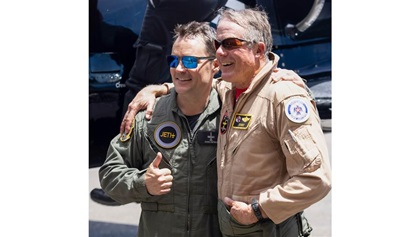 The Patriots begin this flight as they have every flight over the past 20 years: with a thorough preflight briefing followed by a walkthrough of the sequence. The team gathers around a conference table as Wright explains to a group of guests what they will see and hear in the briefing.
The Patriots begin this flight as they have every flight over the past 20 years: with a thorough preflight briefing followed by a walkthrough of the sequence. The team gathers around a conference table as Wright explains to a group of guests what they will see and hear in the briefing.
“This is something they have heard a thousand times, and they could almost repeat exactly what I’m going to say,” Wright says of the other pilots at the table. “But we also believe in checklists, in muscle memory, and we believe in habit patterns.”
During the 30-minute briefing, every aspect of the flight is discussed. Each pertinent piece of information is covered: How the jets will taxi to the runway, plans for aborted takeoffs, formation rejoins, hard decks and maneuvering altitudes, fuel minimums, and the maneuvers that the team will fly.
As the briefing wraps, Posson presents an emergency scenario to the team. It’s an exercise the team routinely engages in to establish what different members will do in the event of an abnormal situation. Sometimes the scenario is an electrical failure or a hydraulic issue. Sometimes it’s a fire or an issue that forces a diversion to a different airport. The pilots chair fly it, working through the issue in real time, making radio calls, and rehearsing what each pilot would do to address the emergency.
“Going over [the hills], Three takes a bird,” Posson says, identifying himself by his aircraft number. “Three has an engine failure. Three is diverting to Livermore. Three’s got no power.”
“Four, go chase,” Wright says.
Strickland calls “Four” to confirm he will follow the emergency aircraft and provide assistance. “Four’s chase,” he calls to let the team know he is in position with Three.
“I’m going to be a [flame out] going to Livermore,” Posson says, letting the others know what emergency procedure he will use.
“I’ll go to Livermore tower and announce it,” Strickland says.
“I’ll get on with NorCal and tell them,” says Wright.
“And the crux of this safety is, what do you do with your minions,” Posson asks Wright, who will still have four wingmen with him.
“I’m going to continue to SFO.”
“If everything goes to hell in a handbasket and you’ve got some guys working an emergency, the best thing you can do is do what’s expected,” Posson says. “Be predictable. Stay quiet on the radios. Leave it to us to handle the emergency, and you take care of your people. You don’t want to become part of the problem. You don’t want an emergency to cause you to have an abnormal [situation] or an emergency.”
After the briefing, the pilots mark out an aerobatic box on the hangar floor and walk through the entire performance, mentally preparing themselves. They make every radio call, and some move their hands as if they are manipulating the throttle and stick.
“You’ve heard athletes when they visualize their performance. It’s sort of the same thing for us,” says Wright. “We will find a blank space on the floor, and we will actually walk through the entire performance while we’re thinking about those geographic references that we’re going to brief and that sort of thing. So that’s our visualizations.”
After the walkout, the pilots head to the jets, don their G-suits, and climb into the airplanes with the help of their crew chiefs. Once they’re in the air, they will join up in a loose formation, complete final checks, and prepare to begin the show. The Patriots open with a parade pass in front of the crowd, then all six airplanes pull into a loop. The outer wingmen split off, and the diamond formation completes a barrel roll.
The pilots make holding these formations look easy, but it’s the result of years of training, honing skills, and building familiarity with the airplane. “Look at that beautiful red, white, and blue smoke. It’s a great day for an airshow,” team announcer Michael Temby says.
For the former military pilots on the team, transitioning from fourth-generation fighters to a simpler jet was an adjustment. Strickland describes the F–16 that he flew with the Thunderbirds as a “basically indestructible, 10-G monster with all the power in the world.”
“The L–39 being cable driven with trim tabs, is much more of a conventional airplane,” he said. “It was really tough to get used to flying formation, especially with the turbofan. When you crack the throttle a quarter of an inch, that airplane is going backwards, and you’re never getting back into position in formation.”
The Patriots family
After the jets land, Howell jumps out of the airplane, all smiles. He gives a hug to a couple of his fellow pilots and his crew chief, remarking that it was a great flight. The members of the Patriots Jet Team often describe themselves as a family, and interactions like this show why.
Their connection also comes from a common goal: sharing aviation with airshow audiences. Each team member wants to put on the best airshow that they can. While the pilots are the most visible members of the team, putting on an entertaining airshow takes everyone. At the announcers’ stand, a team safety observer watches the demonstration and takes notes on any safety or quality issues that the pilots can improve on. A team videographer films the demonstration so the pilots can watch it in debrief. The music and narration add excitement and bring energy to the display. Crew chiefs prepare the jets and conduct preflight inspections. Smoke oil technicians mix the dye that gives the Patriots their signature red, white, and blue smoke. Without any one of these roles, the team wouldn’t be what it is.
“The people with the Patriots—it’s a family,” team photographer Cliff George says. “I just can’t say enough about being with the team, the professionalism, the caring for each other and the camaraderie. It’s just such a great feeling to be a part of it.”
